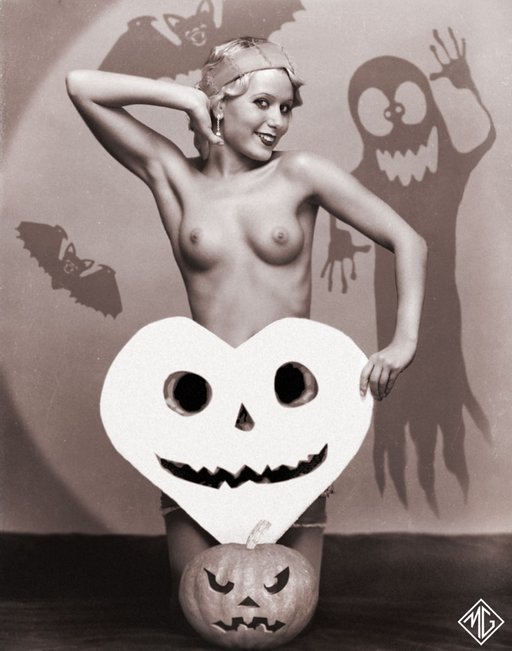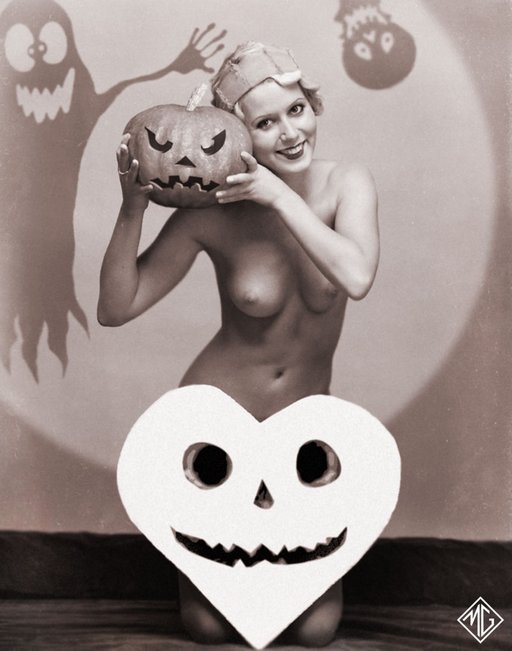That Burlesque Halloween Flapper Chick
A little while ago when @whoresofyore tweeted the above photo out under the hashtag #VintageHalloween I knew I was finally going to have to get off my ass and get this shit in order. I thought I might get something special for my patrons out of it (which didn’t happen, in the event) but mostly I just couldn’t take it any more.
Here is (was) my problem.
I’ve been seeing that photo (and several more from the same series) every Halloween for many years. And why not? The flapper-esque blonde is cute as a button, her tits are perky, and the burlesque Halloween thing is too fun and cute and Betty Boop not to love.
So, my first-stage reaction was “I need to track down that whole series of photos. It would make an awesome Halloween gallery. And if it’s really as old as the some of the clues would indicate, it’s bloody amazing; I want to know more about where these photos come from!”
Sadly, my second-thoughts reaction was “There’s something wrong here. The Halloween iconography is too modern; this is 1950s cheesecake pinup staged as late 1930s burlesque produced with 1920 flappers published by 1900s postcard publishers. Just a whole mishmash of subtle anachronisms.”
My particular problem was with the ghosts and bats and jack-o-lanterns and black cat and happy-skeleton stuff all brought together in one display. You see all of these elements in Halloween imagery going back at least to the Victorians, but a comic erotic burlesque of them? My first mental/visual reference for a thing like that would be the painted cheesecake pinups of the late 1940s and early 1950s. I would be really excited to find them all in a real-photo pinup postcard series from then, but from decades earlier as these photos superficially appear to be? That would be…astonishing.
But hey, a cynical skepticism, no matter how well-informed, is no substitute for doing the work, which for a project like this is quite considerable. Basically, my method is recursive image searching; I start with the first image, and while searching for the largest, best, most-original scan of it, I also look for any pages that offer any provenance, and I also look at all of the “similar images” that the image search engines throw up, saving anything else from the series that turns up. And then I proceed through each of those in stepwise fashion, doing the same for them. It’s a slow, often-tedious, and painstaking process.
There were early indications that something was hinky about this image set.
One thing that bothered me was that diamond “MG” logo. It’s very much like the logos used by photo postcard publishers going back to the turn of the twentieth century and before. Only, a logo like that is typically the initials of the publisher, it’s a handy reference, and it’s usually easy to Google. Those two letters in quotes, “postcard”, and Bob’s your uncle. Collectors and auctioneers are all over that shit. Here? Nothing.
Another thing that bothered me was that as an iron rule, the best-quality scans I was turning up were always 805 pixels wide. That indicated a common digital place of entry onto the internet. Theoretically possible if these photos were from, say, a set of postcards in the hands of a collector, with no other exemplars known; but in practice, usually genuine vintage photos exist in a wide variety of (usually small and terrible) scans of different sizes.
More subtly but also damning, no provenance for any of the photos from the set was turning up. They were widely distributed in copy-and-paste collections of vintage photos, usually mixed with genuine vintage photographs from the “French postcard” and burlesque eras. But nobody had ever taken the time to curate these together into a common gallery. This could just an artifact of digital decay (there’s an awful lot of the adult internet gone missing from the 1997-2007 era) but sometimes it means that the source was known and that the folks doing the copy-and-paste felt constrained from acknowledging that source. But why, if the photos were truly vintage?
As is usually the case, there was just one clue, a single fragile provenance, one person who took the time to drop a credit, that broke the entire mysterious case wide open. One of these images, on a Tumblr that has not yet gotten autoflagged and force-vanished behind the Verizon #pornocalypse Tumblr-porn event horizon, had a link credit to a Deviant Art source, where the photo had been posted more than a dozen years ago by a photographer from the Ukraine who has not been back to DeviantArt since 2005. The photographer went by “MGstudio” (note those “MG” initials) and gave their URL as marthasgirls.com in their DeviantArt profile. Martha’s Girls is a website I vaguely remember; it’s defunct now, but for many years and until sometime in 2016, it ran an old-fashioned subscription paysite selling “The finest emulations of vintage erotica and pin-up, spanning the period from the Victorian times to the 50s pin-up era.” Ding ding ding ding DING! The mystery is solved.
So these are modern, not vintage; they are a formerly-available commercial porn product by an unknown photographer from Dnipropetrovsk whose artistry I quite admire. My hope is that by assembling them here, it will be less likely for future enthusiasts to make the all-too-easy mistake of believing them to be vintage. If you know of more photos from this series, please let me know!
Happy Halloween, and enjoy!
Similar Sex Blogging:
Shorter URL for sharing: https://www.erosblog.com/?p=19631



















I love the range of expressions
Have you seen the model in other shoots?
Very cute. Kudos to the model and the unknown photographer from Dnipropetrovsk.
To me the sharpness of the image and the subtle gray-scale speak to the recent origins, as does the slim and trim figure of the model. Of course those are but suspicions, your tireless investigations are the true proof.
[…] the first to question the vintage authenticity of these images. My research finally took me to Eros Blog, where blogger ‘Bacchus’ had followed up his own doubts about the images, and […]